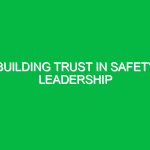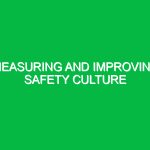Introduction: The Essence of Safety Culture
Safety culture is a term that resonates deeply within the Health, Safety, and Environment (HSE) domain. At its core, safety culture refers to the shared beliefs, practices, and attitudes that shape how an organization approaches safety. An effective safety culture is not merely about compliance with regulations; it is about ingraining safety into the very fabric of daily operations. By fostering an environment where safety is prioritized and openly discussed, organizations can significantly reduce risks and enhance overall performance.
Imagine walking into a manufacturing plant where every employee, from the CEO to the newest intern, understands the importance of safety protocols. They communicate openly about potential hazards, report near misses without fear of reprisal, and actively participate in safety training. This scenario illustrates a thriving safety culture, one where every individual feels responsible for not just their safety but the safety of their colleagues as well. Such an environment not only protects lives but also builds trust and morale among employees.
The Risks and Hazards Associated with Safety Culture
When discussing safety culture, it is essential to identify the potential hazards and risks that can arise when safety is not prioritized. Several factors contribute to an unsafe work environment, and understanding these can help organizations take proactive measures.
Potential Hazards
1. **Poor Communication**: Ineffective communication can lead to misunderstandings about safety protocols. For instance, if a new procedure is not clearly communicated, employees may inadvertently put themselves at risk.
2. **Inadequate Training**: Insufficient training can leave employees unprepared to handle hazardous situations. A construction site, for example, is rife with risks, and without proper training on equipment and safety measures, workers may face serious dangers.
3. **Complacency**: Over time, workers may become complacent about safety practices, especially if they have not experienced incidents in the past. This can lead to a false sense of security, making employees less vigilant.
4. **Lack of Leadership Commitment**: If leadership does not prioritize safety, it sends a message that safety is not important. Employees are likely to mirror this attitude, putting themselves and their coworkers at risk.
5. **Insufficient Reporting Mechanisms**: A culture that discourages reporting near misses or unsafe conditions can result in unaddressed hazards. For example, if workers fear punitive actions for reporting incidents, they may choose to remain silent, allowing dangerous conditions to persist.
Best Practices and Safety Precautions
To cultivate a robust safety culture, organizations must implement best practices that address the identified hazards. Here are some actionable strategies:
1. Promote Open Communication
Encourage employees to speak up about safety concerns. Establish regular meetings where safety topics are discussed openly, and create anonymous reporting systems for those who may feel uncomfortable speaking out. When employees see that their concerns are taken seriously, it fosters trust and engagement.
2. Invest in Comprehensive Training Programs
Regular and thorough training is crucial. Training should not be a one-time event but an ongoing process. Incorporate hands-on training, simulations, and refresher courses to ensure that employees are well-equipped to handle potential hazards. For instance, in a chemical plant, employees should receive regular training on handling hazardous materials and emergency procedures.
3. Cultivate Leadership Commitment
Leadership plays a pivotal role in shaping safety culture. Leaders should not only communicate the importance of safety but also model safe behaviors. They should participate in safety training and be visible in safety initiatives. A personal anecdote from a manufacturing executive highlights this point: after witnessing a near miss, he initiated monthly safety walks through the facility, engaging employees directly and reinforcing the message that safety is a top priority.
4. Implement Regular Safety Audits
Conducting regular safety audits can help identify potential hazards before they result in incidents. These audits should assess compliance with safety regulations, the effectiveness of training programs, and the overall safety environment. Involving employees in these audits can provide valuable insights; their firsthand experiences can uncover issues that management might overlook.
5. Encourage Reporting and Feedback
Develop an easy and non-punitive way for employees to report unsafe conditions or near misses. For instance, creating a simple app or an online portal can streamline reporting, making it more accessible. Furthermore, provide feedback on reported issues to show employees that their input leads to change and improvement.
Regulations and Standards Governing Safety Culture
Organizations must also be aware of the regulations and standards that guide safety culture within the HSE domain. Compliance with these regulations not only ensures legal adherence but also reinforces a commitment to safety.
Occupational Safety and Health Administration (OSHA)
In the United States, OSHA sets and enforces standards to ensure safe and healthful working conditions. OSHA regulations require employers to provide a workplace free from serious hazards and to comply with standards that address specific hazards.
ISO 45001:2018
This international standard outlines requirements for an occupational health and safety management system (OHSMS). It emphasizes the importance of leadership and worker participation in creating a culture of safety.
National Safety Council (NSC)
The NSC promotes safety in the workplace through various initiatives. They provide resources and training to help organizations improve their safety culture and reduce workplace injuries.
Conclusion: Building a Sustainable Safety Culture
In conclusion, safety culture in the HSE domain is not a static concept but a dynamic and evolving aspect of organizational behavior. By understanding the risks associated with poor safety culture and actively implementing best practices, organizations can create an environment where safety is prioritized. This leads to not only a safer workplace but also increased employee morale, productivity, and overall organizational success.
Creating a strong safety culture is a journey, not a destination. It requires continuous effort, commitment from leadership, and active participation from all employees. As we look towards the future, let us remember that every effort made in fostering safety culture contributes to a safer world for everyone.


